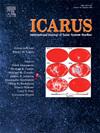属性识别:一种根据视觉特征对行星图像进行分组的新方法,以火星盖尔陨石坑底部富锰岩石为例
IF 2.5
2区 物理与天体物理
Q2 ASTRONOMY & ASTROPHYSICS
引用次数: 0
摘要
在处理没有预定义组的大型数据集时,对图像进行分类尤其具有挑战性。本文提出了一种基于视觉相似性的图像分组方法,使用相对简单的术语,并将该方法应用于NASA好奇号漫游者ChemCam目标图像的视觉相似性分组过程。这种方法是为离线使用而设计的,而不是考虑功率限制的机载应用。鉴于来自ChemCam的大量数据,我们缩小了研究范围,只考虑早期任务和含有高锰的岩石目标。为每个目标评估一个视觉属性的标准列表,对于列表中的每个属性,如果ChemCam目标图像显示该属性,则记录1,否则记录0。这种分析产生的二进制数编码了每个图像的视觉特征,也用于确定图像之间的相似性。将图像建模为网络中的节点,将图像之间的相似性建模为网络中节点之间的边。我们发现,当使用保守的相似性阈值和无向、无加权的图来表示网络时,视觉上相似的图像可以有效地聚类成不相交的连接组件。为了提高最终目标分组的地质实用性,我们定义了弱连接分量的度量,并探索了自动划分弱连接分量的方法。我们将这些结果与加权图方法以及使用随机分区的控制测试进行比较。从201个ChemCam远程微成像仪拼接数据集开始,我们发现“自动划分”方法将这些图像分为13组,并且比其他评估方法产生更好的组内视觉一致性。这些结果可以应用于激励自动属性识别的机器学习模型,以扩展数据标记,以及未来的分类工作,包括公民科学的努力。本文章由计算机程序翻译,如有差异,请以英文原文为准。
Attribute recognition: A new method for grouping planetary images by visual characteristics, using the example of Mn-rich rocks in the floor of Gale crater, Mars
Classifying images is particularly challenging when working with large datasets without predefined groups. We present a new method for grouping images by visual similarity using relatively simple terminology and apply this method to the process of grouping NASA Curiosity rover ChemCam target images into visually similar groups. This method is designed for offline use, rather than on-board applications where power constraints are a consideration. Given the large quantity of data from ChemCam, we narrow the scope of our study to consider only rock targets that are early-mission and contain elevated manganese. A standard list of visual attributes is assessed for each target, and for each attribute on the list, a 1 is recorded if the ChemCam target image exhibits the attribute, and a 0 otherwise. The binary number resulting from this analysis encodes the visual characteristics of each image and is also used to determine similarity between images. Images are modeled as nodes in a network, and similarities between images are modeled as edges between nodes in the network. We find that when using a conservative threshold for similarity and an undirected, unweighted graph to represent the network, visually similar images cluster effectively into disjoint connected components. To improve the geologic usefulness of the resulting target groupings, we define a metric for weak component connectivity and explore methods for automatically partitioning weakly connected components. We compare these results to weighted-graph approaches, as well as to control tests using random partitions. Starting with a dataset of 201 ChemCam Remote Micro Imager mosaics, we found that the “automatic partitioning” method divided these images into 13 groups and resulted in better intra-group visual coherence than the other methods assessed. These results may be applied to motivate machine learning models for automatic attribute recognition to expand data labeling, as well as future classification efforts, including citizen science endeavors.
求助全文
通过发布文献求助,成功后即可免费获取论文全文。
去求助
来源期刊

Icarus
地学天文-天文与天体物理
CiteScore
6.30
自引率
18.80%
发文量
356
审稿时长
2-4 weeks
期刊介绍:
Icarus is devoted to the publication of original contributions in the field of Solar System studies. Manuscripts reporting the results of new research - observational, experimental, or theoretical - concerning the astronomy, geology, meteorology, physics, chemistry, biology, and other scientific aspects of our Solar System or extrasolar systems are welcome. The journal generally does not publish papers devoted exclusively to the Sun, the Earth, celestial mechanics, meteoritics, or astrophysics. Icarus does not publish papers that provide "improved" versions of Bode''s law, or other numerical relations, without a sound physical basis. Icarus does not publish meeting announcements or general notices. Reviews, historical papers, and manuscripts describing spacecraft instrumentation may be considered, but only with prior approval of the editor. An entire issue of the journal is occasionally devoted to a single subject, usually arising from a conference on the same topic. The language of publication is English. American or British usage is accepted, but not a mixture of these.
 求助内容:
求助内容: 应助结果提醒方式:
应助结果提醒方式:


